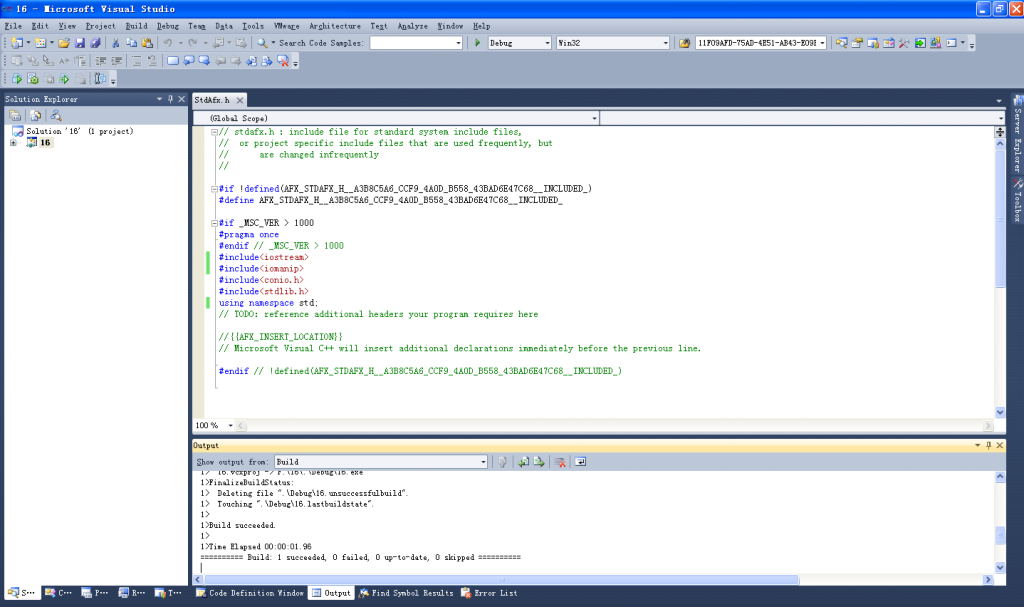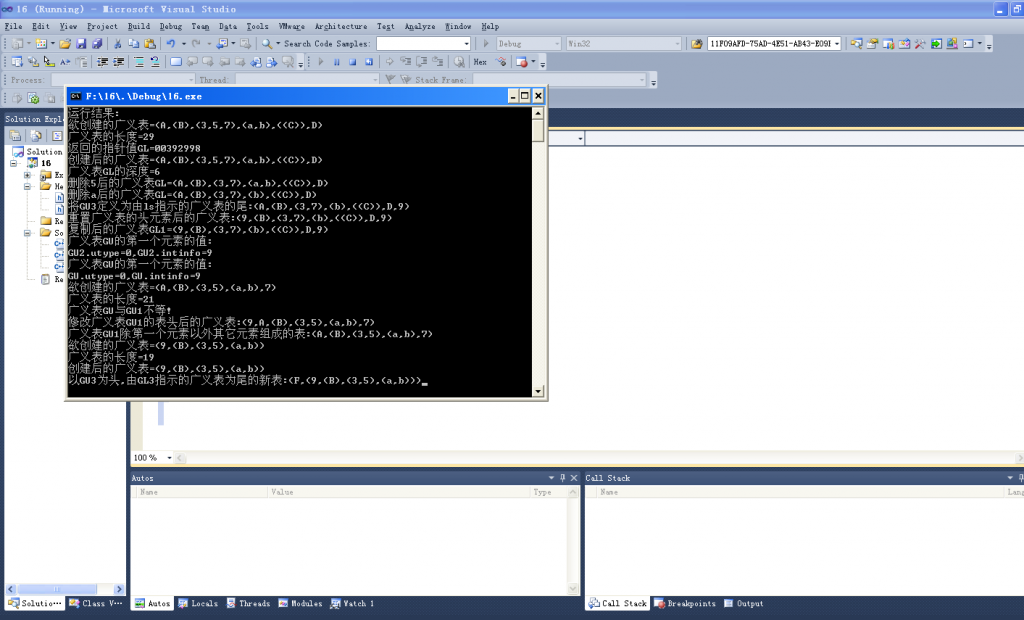线性表被定义为一个有限的序列(a1,a2,a3,…,an)其中ai被限定为是单个数据元素。广义表也是n个数据元素d1,d2,d3,…,dn的有限序列,但不同的是,广义表中的di 则既可以是单个元素,还可以是一个广义表,通常记作:GL=(d1,d2,d3,…,dn)。GL是广义表的名字,通常广义表的名字用大写字母表示。n是广义表的长度。若其中di是一个广义表,则称di是广义表GL的子表。在广义表GL中,d1是广义表GL的表头,而广义表GL其余部分组成的表(d2,d3,…,dn)称为广义表的表尾。由此可见广义表的定义是递归定义的。因为在定义广义表时,又使用了广义表的概念。
l D=() 空表;其长度为零。
l A=(a,(b,c)) 表长度为2的广义表,其中第一个元素是单个数据a,第二个元素是一个子表(b,c)。
l B=(A,A,D) 长度为3的广义表,其前两个元素为表A,第三个元素为空表D。
l C=(a,C) 长度为2递归定义的广义表,C相当于无穷表C=(a,(a,(a,(…))))。
其中,A,B,C,D是广义表的名字。下面以广义表A为例,说明求表头、表尾的操作如下:
head(A)=a; 表A的表头是:a
tail(A)=((b,c)); 表A的表尾是((b,c))。广义表的表尾一定是一个表。
(1) 广义表的元素可以是子表,而子表还可以是子表…,由此,广义表是一个多层的结构。
(2) 广义表可以被其他广义表共享。如:广义表B就共享表A。在表B中不必列出表A的内容,只要通过子表的名称就可以引用该表。 周游广义表(3) 广义表具有递归性,如广义表C。
由于广义表GL=(d1,d2,d3,…,dn)中的数据元素既可以是单个元素,也可以是子表,因此对于广义表,我们难以用顺序存储结构来表示它,通常我们用链式存储结构来表示。表中的每个元素可用一个结点来表示。广义表中有两类结点,一类是单个元素结点,一类是子表结点。从上节得知,任何一个非空的广义表都可以将其分解成表头和表尾两部分,反之,一对确定的表头和表尾可以唯一地确定一个广义表。由此,一个表结点可由三个域构成:标志域,指向表头的指针域,指向表尾的指针域。而元素结点置需要两个域:标志域和值域。
打开IDE 
我们创建一个工程

类的声明如下
#if !defined(AFX_GUANGYI_H__B04529B0_92E5_49C0_954F_629AA89C2F0A__INCLUDED_)
#define AFX_GUANGYI_H__B04529B0_92E5_49C0_954F_629AA89C2F0A__INCLUDED_
#if _MSC_VER > 1000
#pragma once
#endif // _MSC_VER > 1000
//广义表的类定义
#include<string.h>
#include<stdio.h>
#include<math.h>
typedef enum{INTGR,CH,LST}ElemTag;
class GList
{public:
ElemTag utype;
GList *first;
union
{ int intinfo;
char charinfo;
GList *hlink;
};
//构造函数
GList(){}
//返回由elem指示的表元素的值
GList &Info(GList *&elem);
//返回表元素elem的元素值的数据类型
int nodetype(GList *elem) {return elem->utype;}
//将由elem指示的表元素的值修改为x
GList &setInfo(GList *&elem,GList &x);
//判断广义表是否相等的重载函数
int operator ==(GList &m);
//判断广义表是否相等
int equal(GList *s,GList *t);
//返回由ls指示的广义表的第一个元素的值
GList &Head(GList *&ls);
//返回广义表除第一个元素以外其它元素组成的表
GList *Tail();
//返回广义表的第一个元素
GList *First();
//返回由elem指示的表元素的直接后继元素
GList *Next(GList *elem);
//返回一个以x为头,由ls指示的广义表为尾的新表
GList *Addon(GList *ls,GList &x);
//由ls指示的广义表的复制
GList *Copy(GList *ls);
//求由ls指示的非递归表的深度
int depth(GList *&ls);
//判断广义表是否为空
bool GlistEmpty() {return first==NULL;}
//将广义表的头元素重置为x
void setHead(GList *&ls,GList &x);
//将elem2插到表中元素elem1后
void setNext(GList *elem1,GList *elem2);
//将x定义为由ls指示的广义表的尾
void setTail(GList *&ls,GList &x);
//插入元素x作为由ls指示的广义表的第一元素
GList *InsertGL(GList *&ls,GList &x);
//删除广义表中含数x或结点x的操作
GList *delvalue(GList *&ls,int x);
//删除广义表中含数x或结点x的操作
GList *delvalue(GList *&ls,char x);
//S是广义表的书写形式串,由S创建广义表GL
GList *CreateGList(char *&s);
//建立广义表时调用的过程
int sever(char *&str1,char *&hstr1);
//广义表的输出
void prtGlist(GList *h);
};
#endif // !defined(AFX_GUANGYI_H__B04529B0_92E5_49C0_954F_629AA89C2F0A__INCLUDED_)类的实现如下
#include "stdafx.h"
#include "guangyi.h"
//广义表的类实现
//返回由elem指示的表元素的值
GList &GList::Info(GList *&elem)
{static GList *pitem=new GList;
pitem->utype=elem->utype;
if(elem->utype==LST)
pitem->hlink=elem->hlink;
if(elem->utype==INTGR)
pitem->intinfo=elem->intinfo;
if(elem->utype==CH&&elem->charinfo!=')')
pitem->charinfo=elem->charinfo;
pitem->first=elem->first;
return *pitem;
}
//将由elem指示的表元素的值修改为x
GList &GList::setInfo(GList *&elem,GList &x)
{elem->utype=x.utype;
if(x.utype==INTGR)
elem->intinfo=elem->intinfo;
if(x.utype==CH&&x.charinfo!=')')
elem->charinfo=x.charinfo;
return *elem;
}
//返回由ls指示的广义表的第一个元素的值
GList &GList::Head(GList *&ls)
{static GList *temp;
if(ls==NULL)
{cout<<"Illegal head operation.\n";exit(1);}
else {
temp=new GList;
ls=ls->first;
temp=ls;
if(ls->utype==INTGR)
temp->intinfo=ls->intinfo;
if(ls->utype==CH)
temp->charinfo=ls->charinfo;}
temp->first=ls;
return *temp;
}
//返回广义表除第一个元素以外其它元素组成的表
GList *GList::Tail()
{if(first==NULL)
{cout<<"Illegal head operation.\n";exit(1);}
return first->first;
}
//返回广义表的第一个元素
GList *GList::First()
{if(hlink==NULL) return NULL;
else return hlink;
}
//返回由elem指示的表元素的直接后继元素
GList *GList::Next(GList *elem)
{if(elem->first==NULL) return NULL;
else return elem->first;
}
//插入元素x作为由ls指示的广义表的第一元素
GList *GList::InsertGL(GList *&ls,GList &x)
{if(ls->hlink==NULL) ls->hlink=&x;
else {
static GList *temp=new GList;
temp->utype=x.utype;
temp->first=ls->first;
temp->intinfo=x.intinfo;
ls->hlink=temp;
ls->first=temp;}
return ls;
}
//返回一个以x为头,由ls指示的广义表为尾的新表
GList *GList::Addon(GList *ls,GList &x)
{static GList *p=new GList;
p->utype=x.utype;
if(x.utype==INTGR) p->intinfo=x.intinfo;
if(x.utype==CH) p->charinfo=x.charinfo;
p->first=Copy(ls);
ls=p;
return ls;
}
//将广义表的头元素重置为x
void GList::setHead(GList *&ls,GList &x)
{static GList *temp=new GList;
temp->utype=x.utype;
if(x.utype==INTGR) temp->intinfo=x.intinfo;
if(x.utype==CH&&x.charinfo!=')') temp->charinfo=x.charinfo;
temp->first=ls->first->first;
ls->first=temp;
ls->hlink=temp;
}
//将elem2插到表中元素elem1后
void GList::setNext(GList *elem1,GList *elem2)
{GList *temp;
while(elem1->first!=NULL)
{temp=elem1->first;
elem2->first=temp->first;
delete temp;}
elem1->first=elem2;
}
//将x定义为由ls指示的广义表的尾
void GList::setTail(GList *&ls,GList &x)
{static GList *r,*q,*p,*temp=new GList;
temp->utype=x.utype;
if(x.utype==INTGR) temp->intinfo=x.intinfo;
if(x.utype==CH&&x.charinfo!=')') temp->charinfo=x.charinfo;
r=ls;
while(!(r->charinfo!=')'&&r->first->first->first==NULL))
{p=r->first;r=r->first;}
q=p->first;
p->first=temp;
temp->first=q;
}
//由ls指示的广义表的复制
GList *GList::Copy(GList *ls)
{static GList *gh,*q,*p=new GList;
q=p;
if(ls)
do {
gh=new GList;
p->utype=ls->utype;
switch(ls->utype)
{case INTGR:p->intinfo=ls->intinfo;break;
case CH:p->charinfo=ls->charinfo;break;
case LST:p->hlink=ls->hlink;break;
}
p->first=ls->first;
ls=ls->first;
p=gh;
}while(ls->first!=NULL);
p->first=NULL;
return q;
}
//求由ls指示的非递归表的深度
int GList::depth(GList *&ls)
{GList *temp=ls;
int m=0;
if(temp->first==NULL) return 0;
do
{if(temp->utype==LST) m++;
temp=temp->first;
}while(temp!=NULL);
return m;
}
//判断广义表是否相等的重载函数
int GList::operator ==(GList &m)
{int k=equal(first,m.first);
return k;
}
//判断广义表是否相等
int GList::equal(GList *s,GList *t)
{int x;
if(s->first==NULL&&t->first==NULL) return 1;
if(s->first==NULL&&t->first==NULL&&
s->first->utype==t->first->utype)
{if(s->first->utype==INTGR)
if(s->first->intinfo==t->first->intinfo) x=1;
else x=0;
else if(s->first->utype==CH)
if(s->first->charinfo==t->first->charinfo) x=1;
else x=0;
else x=equal(s->first->first,t->first->first);
if(x) return equal(s->first,t->first);
}
return 0;
}
//删除广义表中含数x或结点x的操作
GList *GList::delvalue(GList *&ls,int x)
{static GList *r,*p,*q=ls;
p=ls;
while(ls!=NULL)
{p=ls->first;
while(p!=NULL&&p->utype==INTGR&&p->intinfo==x)
{r=p->first;
delete p;
p=r;break;}
if(p==r){ls->first=r;break;}
ls=ls->first;
}
return q;
}
//删除广义表中含数x或结点x的操作
GList *GList::delvalue(GList *&ls,char x)
{static GList *r,*p,*q=ls;
p=ls;
while(ls!=NULL)
{p=ls->first;
while(p!=NULL&&p->utype==CH&&p->charinfo==x)
{r=p->first;
delete p;
p=r;break;}
if(p==r){ls->first=r;break;}
ls=ls->first;
}
return q;
}
//S是广义表的书写形式串,由S创建广义表GL
GList *GList::CreateGList(char *&s)
{GList *r,*q,*p;
p=q=new GList;
p->first=NULL;
char *sub=new char[30];
char *hsub=new char[30];
for(int i=0;i<30;i++) hsub[i]=sub[i]='\0';
strncpy(sub,s,strlen(s));
sub[strlen(s)]='\0';
cout<<"欲创建的广义表="<<s<<endl;
cout<<"广义表的长度="<<strlen(s)<<endl;
if(strlen(sub)==0||!strcmp(sub,"()")) p->first=NULL;
else
{do
{sever(sub,hsub);
if(strlen(hsub)==1)
{if(48<=hsub[0]&&hsub[0]<=57)
{r=new GList;r->first=NULL;
p->utype=INTGR;p->intinfo=atoi(hsub);
p->first=r;p=r;}
else
{if((65<=hsub[0]&&hsub[0]<91)||(hsub[0]>=97&&hsub[0]<123)||hsub[0]==')')
{r=new GList;r->first=NULL;
p->utype=CH;p->charinfo=hsub[0];
p->first=r;p=r;}
else
{if(hsub[0]=='(')
{r=new GList;r->first=NULL;
p->utype=LST;p->hlink=r;
p->first=r;p=r;
}}}}
}while(*sub!='\0');
p->first=NULL;
}
return q;
}
//建立广义表时调用的过程
int GList::sever(char *&str1,char *&hstr1)
{char ch;int i=0,k=0,j=0;
int n=strlen(str1);
static int m=1;
if(m==1)
while(j<n||k!=0)
{ch=str1[j];j++;m++;
if(ch=='\0') break;
if(ch=='(') k++;
else if(ch==')') k--;}
if(k!=0) return 0;
for(i=0;i<n;++i)
{ch=str1[i];
if(ch=='\0') break;
if(ch==',')
{for(int i0=i;i0<n;i0++)
str1[i0]=str1[i0+1];
break;}}
if(n>1) {
strncpy(hstr1,str1,1);
strncpy(str1,str1+1,n-1);str1[n-1]='\0';
return 1;}
else if(n==1)
{strncpy(hstr1,str1,1);
str1[0]='\0';return 1;}
else return 0;
}
//广义表的输出
void GList::prtGlist(GList *h)
{GList *q,*p=h;
if(h)
do
{if(p->utype==INTGR)
{q=p->first;
if(q->charinfo==')'||q->first==NULL)
cout<<p->intinfo;
else cout<<p->intinfo<<',';
p=p->first;}
else
{if(p->utype==CH)
{q=p->first;
if(q->charinfo==')'||q->first==NULL)
cout<<p->charinfo;
else cout<<p->charinfo<<',';
p=p->first;}
else
if(p->utype==LST)
{cout<<'(';p=p->first;}
}
}while(p->first!=NULL);
}
类的调用如下
#include "stdafx.h"
#include "guangyi.h"
static GList *GL,*GL1,*GL2,*GL3;
static GList GU,GU1,GU2,GU3,GU4;
void main()
{cout<<"运行结果:\n";
char *a="(A,(B),(3,5,7),(a,b),((C)),D)";
char *b="(A,(B),(3,5),(a,b),7)";
char *c="(9,(B),(3,5),(a,b))";
GU3.utype=INTGR;GU3.intinfo=9;
GU3.first=GL2;
GL=GU.CreateGList(a);
cout<<"返回的指针值GL="<<GL<<endl;
cout<<"创建后的广义表=";
GU.prtGlist(GL);
cout<<"\n广义表GL的深度="<<GU.depth(GL);
GL=GU.delvalue(GL,5);
cout<<"\n删除5后的广义表GL=";GU.prtGlist(GL);
GL=GU.delvalue(GL,'a');
cout<<"\n删除a后的广义表GL=";GU.prtGlist(GL);
cout<<"\n将GU3定义为由ls指示的广义表的尾:";
GU.setTail(GL,GU3);GU.prtGlist(GL);
cout<<"\n重置广义表的头元素后的广义表:";
GU.setHead(GL,GU3);GU.prtGlist(GL);
GL1=GU.Copy(GL);
cout<<"\n复制后的广义表GL1=";
GU.prtGlist(GL1);
cout<<"\n广义表GU的第一个元素的值:\n";
GU2=GU.Head(GL1);
cout<<"GU2.utype="<<GU2.utype;
if(GU2.utype==INTGR)
cout<<",GU2.intinfo="<<GU2.intinfo<<endl;
if(GU2.utype==CH)
cout<<",GU2.charinfo="<<GU2.charinfo<<endl;
GU=GU.Info(GL1);
cout<<"广义表GU的第一个元素的值:\n";
cout<<"GU.utype="<<GU.utype;
if(GL1->utype==INTGR)
cout<<",GU.intinfo="<<GU.intinfo<<endl;
if(GL1->utype==CH)
cout<<",GU.charinfo="<<GU.charinfo<<endl;
GL2=GU1.CreateGList(b);
if(GU.operator ==(GU1)) cout<<"广义表GU与GU1相等!\n";
else cout<<"广义表GU与GU1不等!\n";
cout<<"修改广义表GU1的表头后的广义表:";
GL2=GU1.InsertGL(GL2,GU3);
GU1.prtGlist(GL2);
GU1=*GL2;
cout<<"\n广义表GU1除第一个元素以外其它元素组成的表:";
GL2=GU1.Tail();cout<<'(';
GU1.prtGlist(GL2);cout<<endl;
GL3=GU4.CreateGList(c);
cout<<"创建后的广义表=";
GU4.prtGlist(GL3);
cout<<"\n以GU3为头,由GL3指示的广义表为尾的新表:";
GU3.utype=CH;GU3.charinfo='F';
GU3.first=NULL;
GL3=GU4.Addon(GL3,GU3);cout<<'(';
GU4.prtGlist(GL3);cout<<')';
getch();
}
效果如下

代码下载
http://download.csdn.net/detail/yincheng01/4788413